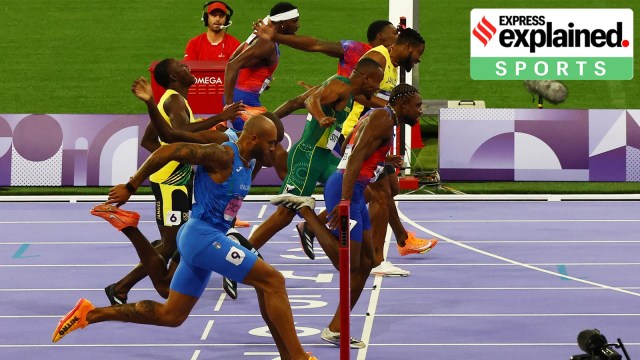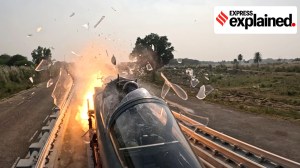How Noah Lyles won the greatest ever Olympic 100m race in Paris
People have run faster races in the past, but no race has been as close as this one. The photo finish cameras at the finish line found Lyles to have just edged out Kishane Thompson.
 Photo finish: Lyles (in red and blue) is seen leaning forward at the line. (Reuters Photo)
Photo finish: Lyles (in red and blue) is seen leaning forward at the line. (Reuters Photo)The Olympics had never seen such a rush at the finish line of a 100 m final as it did on late Sunday night (August 4), at the iconic Stade de France in Saint-Denis.
In the end, US track and field star Noah Lyles leaned forward at the perfect time to be just 0.005 seconds faster than Jamaica’s Kishane Thompson to win a gold in a photo finish. All eight sprinters, bunched together for most of the race, finished with sub-10 second timings.
People have run faster races in the past, but no race has been as close as this one.
A close bunch
For collective brilliance, Sunday’s race was absolutely the greatest 100 m final of all time, as for the very first time in history, all eight men clocked sub-10 second timings under legal wind conditions. According to World Athletics, “a 100 m sprint time will only be considered ‘wind legal’ if the wind speed is 2m/s or less”.
Jamaica’s Oblique Seville finished last, but his 9.91 seconds timing would have been good enough for a third place finish at the Tokyo Olympics, three years ago. Defending champion Marcela Jacobs of Italy finished fifth with a timing of 9.85 seconds, good enough for a second place in the Beijing Olympics when Usain Bolt set the then Olympic record 9.69 second timing.
All in all, sprinters from the fourth to eighth place recorded best-ever times in a 100 m race.
Photo finish for gold
In real time, the race was too close to call. Both Lyles and Thompson were credited with a time of 9.78 seconds, which flashed on TV screens across the world. On air, commentators felt that Thompson had won the race by a whisker, but broadcast cameras are simply incapable of giving an accurate picture for such close finishes.
This is where the fully automated timing and photo finish system, which records the timings of all athletes, comes in. This comprises three things:
* The starter’s pistol, resembling a modern-day gas lighter, triggers a flash of green light and a sound mimicking the crack of a gun from small speakers behind atheltes’ starter blocks. It also kickstarts the timing device.
* Sensors are embedded on the starting block to catch false starts. They measure the pressure of an athlete’s foot on the block, 4,000 times a second. World Athletics rules deem a reaction time of less than a tenth of a second as a false start because the human mind cannot react to the starter’s pistol faster than this.
* At least two cameras on either side of the finish line provide a composite image of the sprinters. World Athletics requires these cameras to be able to take a minimum of 1,000 images per second. Omega, the official time-keeper of the Olympics, has been using cameras that take 40,000 images per second at the finish line in Paris, up from the 10,000 images per second taken during the Tokyo Games.
The photo finish cameras at the finish line found Lyles to have just edged out Thompson, despite overhead cameras showing that Thompson’s foot crossed the line ahead of Lyles. This is because the athlete’s torso has to cross the finish line to be counted, not his head, arms, neck, or feet.
Lyles won by five-thousands of a second because he got his torso to break the line first. Rewatch the race in slow motion to see Lyles dip just slightly quicker using his right shoulder, with his experience of being a 100 m, 200 m and 4×100 m relay world champion coming good in the big final.
- 01
- 02
- 03
- 04
- 05






































